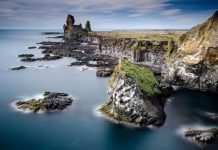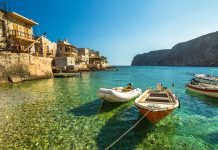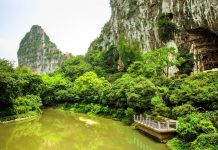A city where you still need to install signs to prohibit tractors from driving along the main street does not seem a promising place, but it is worth delving into the maze of streets diverging from the noisy Cumhuriyet Caddesi, and you will find the destructive remnants of former glory literally at every step.
Formerly rich Ottoman mansions are slowly decaying, creating a picturesque picture of oblivion within Kastamonu, and on the shopping streets you can hang out among the locals in search of a bargain. This is a piece of provincial Turkey, not yet fully mastered by tourists. Just outside the city there is a wooden Kasaba mosque decorated with fancy carvings and paintings – it’s worth staying here for the night.
History
The history of Kastamonu, as well as most of the cities of Central Turkey, is very colorful. The results of archaeological research suggest that the settlement at this place arose as early as 2000 BC, but the Hittites, Persians, Macedonians and Pongian kings left their mark here. In the XI century, the Seljuks settled in the region, then the Danyshmendids. In the XIII century, the Byzantine Emperor John Komnenos tried to stay here, but soon the Mongols descended, followed by the Ottomans.
Incredibly, the modern history of Kastamonu is inextricably linked with headdresses: here, in 1925, Ataturk began his reforms of headdresses, banning the wearing of fezzes because of their religious background, and insisted on using European-style hats.
Attractions
Archaeological Museum
To the south of the Nasrullah Bridge there is a small museum with well-placed exhibits and detailed labels in English. The central hall is dedicated to the role of Kastamonu in the Ataturk revolution, and in the hall on the left you can see Hellenistic and Roman finds. The objects of the Hittite civilization and the Bronze Age, found during excavations in the region, are on display at the top.
Nasrullah Meydani
If you walk away from the Nasrullah Bridge, you will find the Ottoman Nasrullah Jami Mosque on the square. During the War of Independence, the poet Mehmet Akif Ersoy delivered his speeches in this mosque. In the former madrasah of the Uniform, in the back of the square, there are several shops with handicrafts. To the west of the square are the buildings of the old market, including the Ashirefendi caravanserai and the Ismail Bey caravanserai built in the XV century.
Castle
One block south of the Archaeological Museum, turn right onto §eyh §aban Veli Caddesi and follow up the road to the ruins of the castle of Casta Monu. Part of the building dates back to Byzantine times, but the fortress was reconstructed under the Seljuks and Ottomans.
Ethnographic Museum
To the south of the Nasrullah Bridge, on Cumhuriyet Caddesi, turn right after Gazi Pasha School and reach the Konaga Liva Pasha restored in 1870, upstairs you can see the salons, furnished as in Ottoman times.
Surroundings of Kastamonu
KASABA
Hidden among the rounded hills and fertile fields is the tiny village of Kasaba, located 17 km northwest of Kastamonu, it is charming, but it does not look like a suitable place for one of the finest preserved wooden mosques in Turkey. The restored interior of the Mahmoud Bey Jami Mosque includes four painted wooden columns, a wooden gallery and exquisitely painted rafters. You can climb the rough stairs to the fourth tier of the gallery to see the ornately decorated ends of the beams and the intertwining motifs crowning the columns.
PYNARBASHI
Pynarbashi is the main access point to the Cure Daglari National Park, spread over 37,000 hectares. Despite some marketing efforts by the local government, the Cure Mountains are still little known to tourists, so you are very likely to get the park at your sole disposal. In addition to the park, it is worth exploring the Ilgarini and Ilidzha caves, the Ilidzha Waterfall and the Khorma Canyon.
Small pine cabins in Park Ilica Turizm Tesisi near the Ilych Waterfall will serve as an excellent base for exploring the park. There is also a restaurant, and nearby there are thermal springs where you can swim.
Bogazkale, Hattusa and Yazylykaya
In the center of the Anatolian Plain there are two UNESCO World Heritage Sites that reflect vital historical moments during the heyday of the Hittite civilization. Hattusa was the capital of the Hittite kingdom, and Yazylykaya was a religious shrine decorated with magnificent stone carvings.










